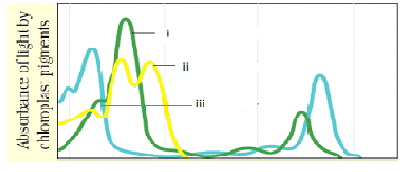Products of light reaction does not include-
a. ATP & NADPH
b. CO2
c. O2
d. Electrons
a. ATP & NADPH
b. CO2
c. O2
d. Electrons
Absorption spectrum of chlorophyll- ‘a’ is shown by-

1. I
2. II
3. III
4. Not shown.
How many pigments are responsible for the color of a plant leaf?
a. 1
b. 2
c. 3
d. 4
After performing the chromatographic separation of a plant leaf, experimentor found bright or blue green colour in the chromatogram. Then this pigment should be-
a. xanthophyll
b. carotenoid
c. chlorophyll a
d. chlorophyll b.
Range of wavelength at which chlorophyll-a shows the maximum absorption:
a. 400-450 nm
b. 450-500 nm
c. 650-700 nm
d. 500-600 nm.
Which of the following is the chief pigment associated with photosynthesis?
1. chl-a
2. chl-b
3. chl- a and xanthophylls
4. chl-a and carotenoids
How statements are correct?
i. chlorophyll-a , xanthophylls and carotenoids are called as accessory pigments.
ii. accessory pigments protect chlorophyll-a from photo-oxidation.
iii. chlorophylla are the major pigments responsible for trapping of light
iv. chl-a and chl-b forms the reaction centre
v. chl-a transfers the energy to accessory pigments.
a. 2
b. 3
c. 4
d. 5
Photochemical phase does not include-
a. water splitting
b. oxygen release
c. CO2 assimilation
d. light absorption
Which of the following statement is incorrect?
| 1. | Reaction centre is formed by a group of chl- a molecules. |
| 2. | Reaction centre is different in both the photosystems. |
| 3. | In PS I the reaction centre chlorophyll a has an absorption peak at 700 nm. |
| 4. | In PS II the reaction centre chlorophyll a has absorption maxima at 680 nm. |
In photosystem-I, P700 refers to-
| 1. | chl-b |
| 2. | chl-a |
| 3. | number of pigment molecules |
| 4. | absorption peak of chl-a at 700nm. |






